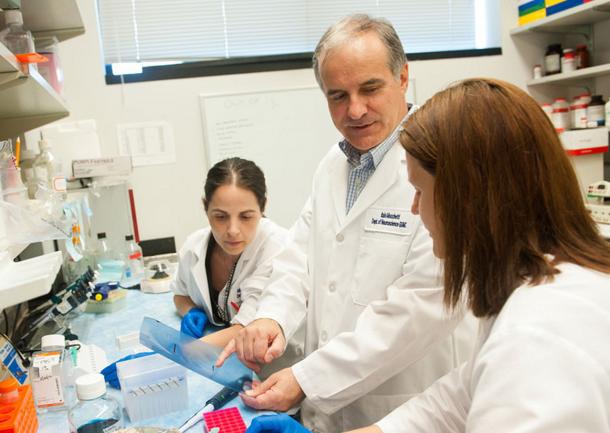HIV REVEALS GENERAL THEORY OF DEMENTIA
July 18, 2012 – It was a puzzle. Individuals infected with HIV who also were known to abuse drugs such as cocaine and morphine were developing the telltale signs of dementia — even though they were in their 20s and 30s. They became profoundly depressed, and had trouble remembering, learning, even moving. Their brains acted as if they were half a century or more older.

But while antiretroviral therapy to keep HIV at bay helped reduce the incidence of HIV-associated dementia, clinicians were not sure if the disorder arose because of the virus or the drugs — or a disastrous interaction between the two.
Italo Mocchetti, Ph.D., a professor and vice chair of the department of neuroscience at Georgetown University Medical Center (GUMC), decided to find out. Since Mocchetti came to GUMC in 2002, he had studied Parkinson’s disease, but he began to focus on HIV and AIDS due to the widespread nature of the disorder. The Centers for Disease Control and Prevention estimate more than 1 million people in the U.S. are HIV-positive, not including the 600,000 who have died after their infection progressed to AIDS. The agency also says that every 9.5 minutes, someone in America is newly infec
ted with the virus — and Mocchetti knows that if they are left untreated, about a third will develop cognitive decline.
So Mocchetti applied for a grant from the National Institute on Drug Abuse to tease out the cause of HIV-associated dementia. “It’s important to know where we need to focus care for the
se patients — should we inhibit the effects of the drugs or find a new and different way to stop the virus than is currently available?” he asks.
A new, general theory of dementia
The answer was published July 11 in the Journal of Neuroscience by Mocchetti and his team — first author Alessia Bachis, Ph.D., as well as Valeriya Avdoshina, Ph.D., and Maia Parsadanian, all from the Department of Neuroscience at GUMC, and Luigi Zecca, Ph.D., from the Institute of Biomedical Technologies in Segrate, Italy.
They found that despite the fact that HIV is known not to be able to infect brain neurons, it attacks a protein growth factor that keeps neurons healthy. When this molecule — mature brain derived neurotrophic factor (mature BDNF) —is in short supply, the synapses of affected neurons shrink, losing their connections to other neurons. And they die.
It is the same phenomenon seen in aged brains as well as in different kinds of dementia.
And it goes like this: neurons secrete an immature form of BDNF known as proBDNF. It is then the role of an enzyme, known as furin, to cut proBDNF in such a way that it makes healthy matureBDNF, which then nurtures the neurons. The virus inhibits furin from working, resulting in a surfeit of proBDNF, which is toxic on its own.
Old brains can also have too much proBDNF, Mocchetti says. “The balance between healthy BDNF and toxic BDNF has been found to be skewed in individuals who have developed age-related dementia,” he says.
“The link between depression and lack of mature BDNF is also known, as is the link to issues of learning and memory. That’s why I say HIV-associated dementia resembles the aging brain.”
A break in the study came when Mocchetti and his team were able to study the blood from 130 women who were enrolled in the 17 year-old, nationwide Women’s Interagency HIV Study, (directed at Georgetown by Mary Young, M.D.), which has focused on the effects of HIV in infected females. In an earlier finding, the scientists found that when there was less BDNF in the blood, patients were at risk of developing brain abnormalities. He published this finding in the May 15, 2011 issue of AIDS.
In this study, the team was able to study the brains of HIV-positive patients who had died, and who had developed HIV-associated dementia. They discovered these neurons had also shrunk, and that mature BDNF was substantially decreased. Then they worked out the mechanism responsible for this destruction.
Mocchetti doesn’t know why HIV attacks furin, shutting it down, but he theorizes that matureBDNF stops the virus from attacking other cells in the brain, such as microglial cells and brain macrophages.

Loss of mature BDNF not only results in HIV-associated dementia along with some forms of elderly dementia, it has also been suggested to be a risk factor in chronic diseases such as Parkinson’s and Huntington’s diseases, Mocchetti says. “ProBDNF is also found at a much higher rate in Alzheimer’s disease,” he says.
The findings suggest a possible therapeutic intervention, Mocchetti adds. “One way would be to use a small molecule to block the specific cell receptor that proBDNF uses to kill neurons. A small molecule like that could get through the blood-brain barrier.
“If this works in HIV-dementia, it may also work in other brain issues caused by proBDNF, such as aging,” he says.
The study also suggests that measuring proBDNF in HIV-positive patients may provide a biomarker of risk for development of dementia, he adds.
“This finding is extremely important for both basic scientists and physicians, because it suggests a new avenue to understand, and treat, a fairly widespread cause of dementia,” Mocchetti says.
“Although I turned briefly from focusing on Parkinson’s disease to HIV, I have come across a mechanism that appears to be common to both disorders, and that is rewarding to me,” he says. “New therapy based on this discovery will not be forthcoming soon, but it gives us hope.”
Research described here was supported by grants from the U.S. Department of Health and Human Services (1R01DA026174 and U01MH083501) and the Latham Trust Fund.
